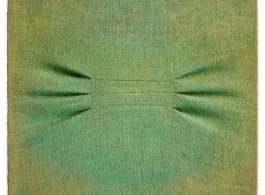27.10.2016 – 03.12.2016
Opening on 27 October, 6-9 pm, in presence of the artist
Tsuyoshi Maekawa in the 1970s
Koichi Kawasaki
Essay written on the occasion of the solo exhibition Tsuyoshi Maekawa in the 1970s at Axel Vervoordt Gallery, Antwerp, Belgium (27 October – 3 December 2016)
The 1970s were a difficult period for the former members of the Gutai Art Association to maintain their identities as artists. The sudden death of the group’s charismatic leader, Jiro Yoshihara, in 1972 seems to have caused them a great deal of anxiety about their future. More than the early members—whom had already established their style—the middle- and late-period members lost their artistic bearings and were unsure how to proceed. It was common practice for Yoshihara to have final say on which works were included in every Gutai exhibition. Rather than offering his charges advice, Yoshihara, in his superior role, would select the works that struck him as the most outstanding. The artists apparently made their work in the hope that it would catch Yoshihara’s attention.
A sense of despair pervaded the meeting held by Kazuo Shiraga and other key members in late March 1972 to discuss Gutai’s dissolution. The fact that they agreed never to use the name “Gutai” again in the future indicates how important the group was to them. Seeing this decision in a positive light, Tsuyoshi Maekawa says that he imagined Yoshihara telling him to “do his best on his own” and remembered the Gutai spirit of doing something that no one had ever done before, and consciously set out to achieve even greater originality in his work.
There is something truly amazing about the way in which Maekawa’s art developed after he joined Gutai in the early sixties. With every exhibition, his efforts grew increasingly profound as he freely manipulated burlap and sewed it into complex waveforms. After quitting his day job, which had many constraints that cut down on his time to make art, Maekawa began a new career as a freelance designer. Incidentally, when the Gutai exhibition, Expo ’70, was held in Osaka in 1970 he apparently continued to adjust the works until the very end of the event.
During the period after Yoshihara’s death when many group members were searching for a direction, Maekawa concentrated on showing his work in solo and invitational group exhibitions. At times he became so busy with his design work that he did not have enough time or money to make art. This was a harsh reality for him to face. In 1974, Maekawa established his own studio, and the following year he stopped working as a designer. Instead, he began supporting himself by teaching children’s painting classes in his home.
Around this time, a huge change occurred in Maekawa’s work. While using the same materials he had used in the past, he developed a lighter, more refined style in which he tried to bring out the distinctive features of the fabric without applying too much paint. In some ways, this shift from vigorous color-based work to delicate fabric-based expressions resulted in a loss of dynamism. The artist says that his work was rejected by a succession of invitational exhibitions. When Maekawa’s work was selected for the Japan Art Festival in 1975 (the exhibition later toured New Zealand and Australia as well), it must have served as a great impetus for him.
Maekawa made some large works during this period, but unfortunately, because he was unable to store the pieces that were rejected by various exhibitions, the only works that are extant are small ones. These works are, however, a testament to his elaborate handiwork. The series of boxes that Maekawa made for the Box exhibition, organized by Sadaharu Horio in 1975, in particular foreshadow a new phase in his work. Maekawa challenged himself to see how finely he could sew the fabric or how much he could stretch the slack areas created by sewing a single piece of cloth. It was also challenging to see how simple he could express himself in a work. Traces left by pinching the cloth with his fingers produce small hollows that were beyond his control. In his works from 1979, Maekawa used paint to make wrinkles and shadows, and created shadows with the appearance of virtual images in the raised areas.
In the eighties, by using thin cloth and combining different weaves of fabric, Maekawa produced even more refined two-dimensional work. During this work, he began to be recognized by the invitational exhibitions, and after being awarded the Tokyo Metropolitan Art Museum Prize at the 15th Contemporary Art Exhibition of Japan in 1981, received a succession of prizes at other events.
This was related to the fact that he had established a clear direction and attitude in his work. To Maekawa, the seventies can be seen as a preparatory period in which he moved away from Gutai and discovered a new style.



